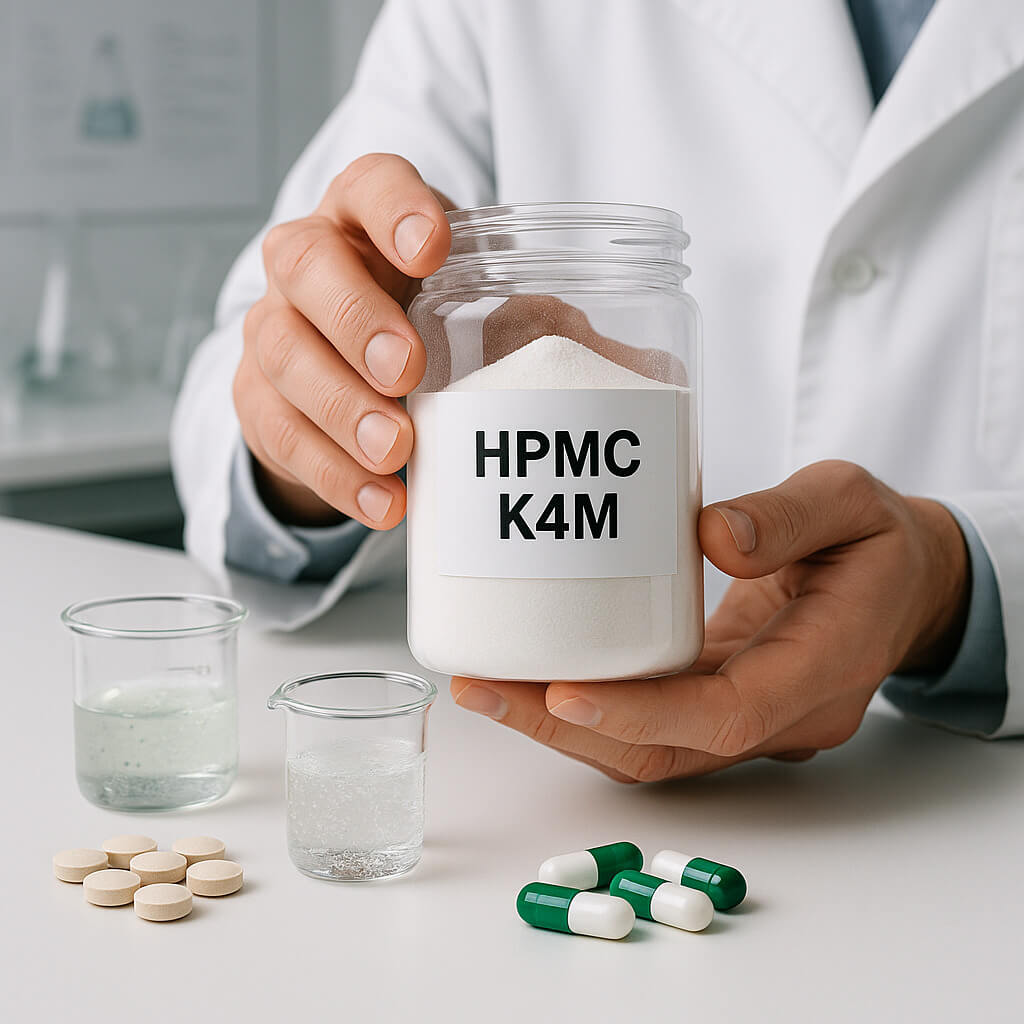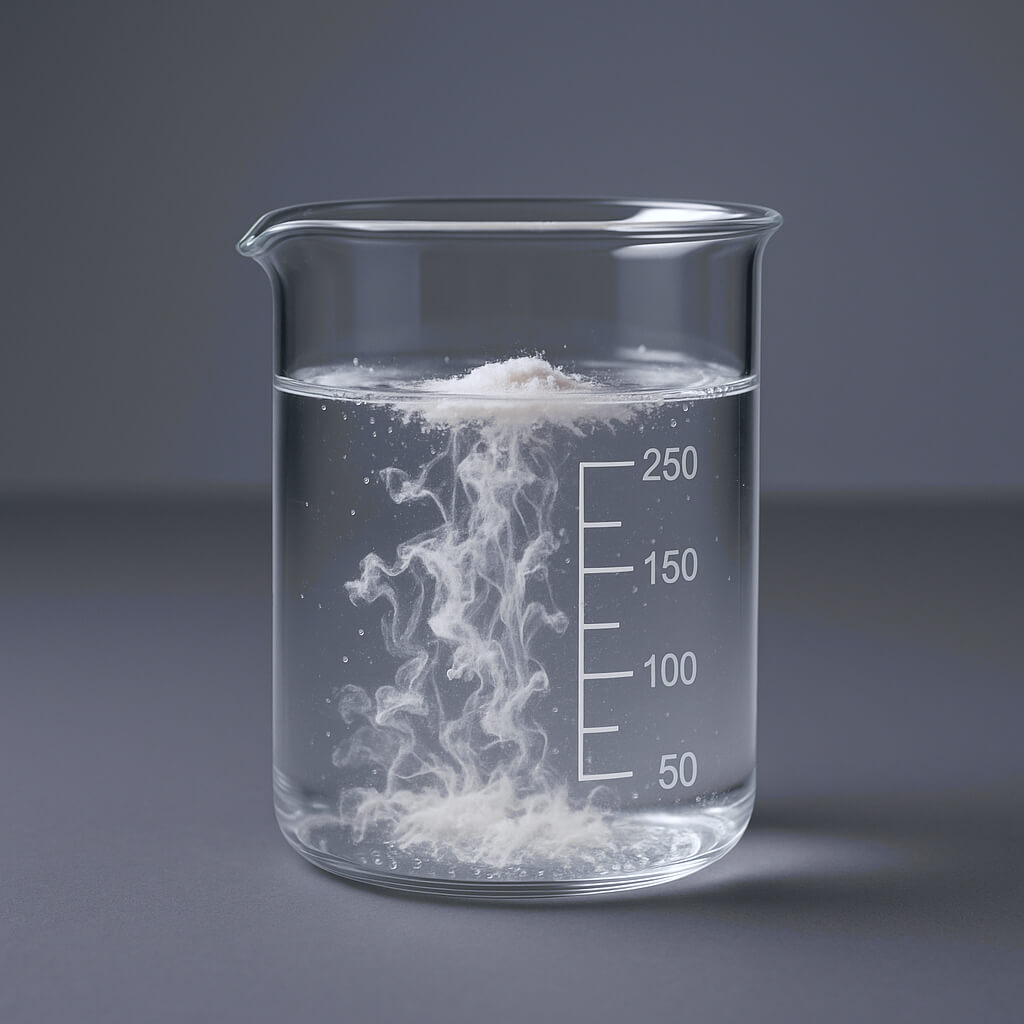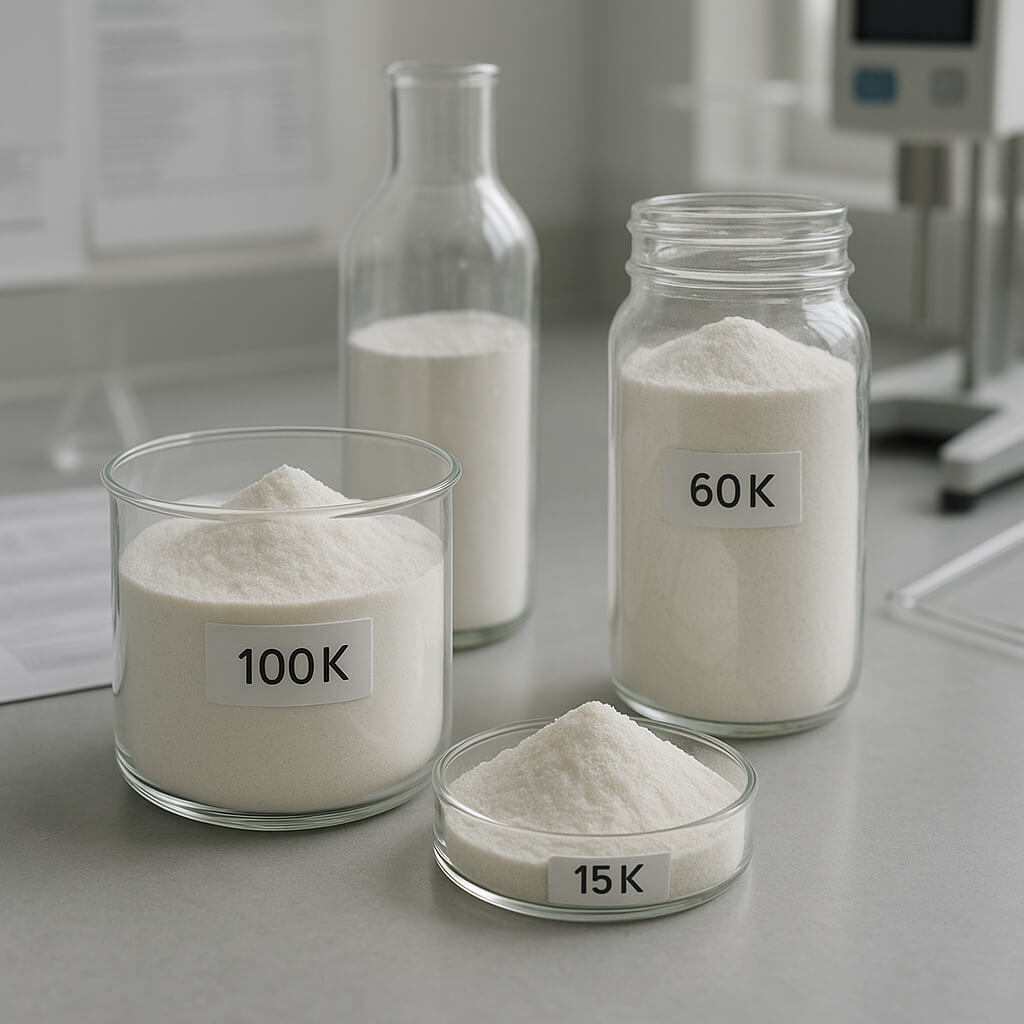Гидроксипропилметилцеллюлоза (ГПМЦ) — производное целлюлозы, играющее важную роль в ряде отраслей, включая фармацевтику, строительство и производство продуктов питания. Его универсальность и уникальные свойства делают его незаменимым для различных применений, где ключевыми являются последовательность, связывание и стабильность. В этой статье рассматриваются основные свойства ГПМЦ, его применение в различных отраслях и значительные преимущества, которые он дает производителям. Понимая эти аспекты, вы будете готовы принимать обоснованные решения об использовании ГПМЦ в своих рецептурах.

1. Что такое гидроксипропилметилцеллюлоза и почему она важна?
Гидроксипропилметилцеллюлоза, или ГПМЦ, — это водорастворимый полусинтетический полимер, полученный из целлюлозы, природного полимера, обнаруженного в клеточных стенках растений. Он модифицирован путем добавления гидроксипропильных и метильных групп, которые придают ему уникальные свойства. Эти модификации позволяют ГПМЦ легко растворяться в воде и образовывать гели, поэтому он широко используется в различных отраслях промышленности.
Почему это важно? Благодаря своей способности образовывать гели и превосходной растворимости, ГПМЦ широко используется в приложениях, где необходим стабильный, однородный продукт. В строительстве он используется для улучшения обрабатываемости сухих смесей, а в фармацевтике он используется в качестве связующего и агента контролируемого высвобождения в таблетках. В производстве продуктов питания он действует как стабилизатор, эмульгатор и загуститель, гарантируя, что продукты сохранят желаемую текстуру и консистенцию.
Важность HPMC невозможно переоценить. Он обеспечивает уникальные функциональные преимущества, которые позволяют производителям оптимизировать свои продукты способами, которые не могут другие полимеры. Будь то улучшение текучести и адгезии строительных материалов, контроль высвобождения лекарств в организме или улучшение текстуры пищевых продуктов, HPMC имеет важное значение для предоставления высококачественных решений.
| Промышленность | Распространенное использование | Роль HPMC |
|---|---|---|
| Фармацевтика | Связующие вещества, агенты с контролируемым высвобождением | Последовательность, контролируемая доставка лекарств |
| Строительство | Растворы, клеи | Улучшает обрабатываемость, адгезию, водоудержание |
| Еда | Эмульгаторы, стабилизаторы | Сохраняет текстуру, предотвращает расслоение |
2. Каковы основные свойства гидроксипропилметилцеллюлозы?
Основные свойства HPMC, которые делают его очень полезным в различных отраслях промышленности, включают его растворимость в воде, контроль вязкости, способность к образованию геля и термическую стабильность. Понимание этих свойств является ключом к оптимизации производительности HPMC в различных приложениях.
Растворимость в воде является одним из важнейших свойств HPMC. Это позволяет полимеру легко растворяться в холодной и горячей воде, образуя гелеобразное вещество, вязкость которого можно регулировать. Это делает его весьма универсальным для применения в различных областях: от фармацевтики до производства продуктов питания, где растворимость имеет решающее значение для достижения желаемой текстуры и консистенции.
Контроль вязкости — еще одно важное свойство HPMC. В зависимости от молекулярной массы и концентрации HPMC может создавать растворы от жидких до высоковязких. В фармацевтике это важно для обеспечения того, чтобы таблетки и капсулы сохраняли надлежащую консистенцию и структуру. В пищевых продуктах контроль вязкости гарантирует, что соусы, супы и другие продукты будут иметь правильную густоту, предотвращая разделение и сохраняя ощущение во рту.
Способность к гелеобразованию позволяет использовать HPMC в системах доставки лекарств с контролируемым высвобождением, поскольку он образует гель, который регулирует высвобождение активных ингредиентов. Он также полезен в строительной отрасли, где HPMC добавляется в сухие смеси для улучшения обрабатываемости и сцепления.
И наконец, Термическая стабильность гарантирует, что HPMC сохраняет свою функциональность при различных температурах. Это особенно важно в пищевой и строительной промышленности, где материалы подвергаются воздействию различных условий окружающей среды.
| Свойство | Функциональность | Приложение |
|---|---|---|
| Растворимость в воде | Легко растворяется в холодной и горячей воде | Фармацевтика, продукты питания, строительство |
| Контроль вязкости | Регулируемая вязкость для различных целей | Фармацевтика, продукты питания, клеи |
| Способность к гелеобразованию | Создает гели для контролируемого высвобождения | Фармацевтика, строительство |
| Термическая стабильность | Сохраняет функциональность при разных температурах | Продукты питания, строительство, фармацевтика |
3. Как гидроксипропилметилцеллюлоза используется в фармацевтической промышленности?
В фармацевтической промышленности ГПМЦ используется в основном как связующее и агент с контролируемым высвобождением в таблетированных формулах. функция связующего вещества необходим для обеспечения того, чтобы активные ингредиенты в таблетках удерживались вместе, сохраняя целостность таблетки и гарантируя, что она не раскрошится и не растворится преждевременно. Удерживая ингредиенты вместе в однородном виде, ГПМЦ улучшает консистенцию таблетки и способствует ее контролируемому растворению.
Доставка лекарств с контролируемым высвобождением является еще одним важным применением HPMC. В этом процессе HPMC используется для контроля скорости высвобождения препарата в организм, обеспечивая устойчивое высвобождение в течение длительного периода. Это особенно полезно для пациентов, которым необходимы постоянные терапевтические уровни лекарств в течение дня, что снижает необходимость в частом приеме и улучшает соблюдение пациентом режима лечения.
ГПМЦ также используется в фармацевтические гели и средства по уходу за ранами. Его гелеобразующие свойства позволяют использовать его в качестве матрицы для контролируемой доставки активных фармацевтических ингредиентов. При местном лечении ГПМЦ помогает активным ингредиентам эффективно проникать в кожу, сохраняя при этом стабильность в гелевой формуле.
| Фармацевтическое применение | Функция | Выгода |
|---|---|---|
| Связующее | Удерживает активные ингредиенты вместе | Консистенция, целостность таблеток |
| Контролируемый выпуск | Регулирует скорость высвобождения лекарственных средств | Пролонгированное высвобождение, соблюдение пациентом режима лечения |
| Гели и средства для ухода за ранами | Матрица для активных ингредиентов | Контролируемая доставка, стабильность |
4. Какую пользу гидроксипропилметилцеллюлоза приносит пищевой промышленности?
В пищевой промышленности уникальные свойства ГПМЦ делают его бесценным ингредиентом. В качестве загустителя, он помогает достичь нужной текстуры в соусах, супах и заправках. Увеличивая вязкость, ГПМЦ гарантирует, что эти продукты сохранят свою консистенцию и не распадутся во время хранения.
Эмульгирование еще одно ключевое применение HPMC в пищевых продуктах. Он помогает удерживать фазы масла и воды во взвешенном состоянии, предотвращая их разделение. Это особенно важно в таких продуктах, как майонез, мороженое и заправки для салатов, где гладкая, однородная текстура имеет важное значение для удовлетворения потребителя.
ГПМЦ также используется в качестве стабилизатор в различных пищевых продуктах, помогая сохранить текстуру и предотвратить изменения во время обработки или хранения. Например, в безглютеновых или растительных продуктах ГПМЦ может помочь улучшить текстуру и эластичность, придавая этим продуктам лучшее ощущение во рту и более желаемую консистенцию.
Еще одним преимуществом ГПМЦ в производстве продуктов питания является его способность заменять традиционные загустители и стабилизаторы, предлагая веганская и безаллергенная альтернатива к таким ингредиентам, как желатин и яичные белки.
| Применение в пищевой промышленности | Функция | Выгода |
|---|---|---|
| Загуститель | Увеличивает вязкость соусов, супов | Консистенция, предотвращает расслоение |
| Эмульгатор | Удерживает масло и воду во взвешенном состоянии | Гладкая текстура, однородная консистенция |
| Стабилизатор | Сохраняет текстуру во время хранения | Предотвращает изменения, увеличивает срок хранения |
5. Как гидроксипропилметилцеллюлоза применяется в строительной отрасли?
В строительстве HPMC играет важную роль как добавка в сухие строительные смеси, пластыри, и плиточный клей. Его свойства растворимости и контроля вязкости убедитесь, что эти материалы легко смешивать, распределять и наносить, что повышает обрабатываемость. Без ГПМЦ эти материалы могут стать слишком густыми, что затруднит их равномерное распределение, что может отрицательно повлиять на адгезию и прочность соединения.
Задержка воды еще одно важное свойство HPMC в строительстве. Он помогает раствору или штукатурке удерживать влагу, предотвращая преждевременное высыхание и обеспечивая надлежащее отверждение. Это особенно важно в сухом климате или для крупномасштабных проектов, где долгосрочная последовательность имеет решающее значение.
HPMC's свойства, способствующие адгезии полезны в таких применениях, как плиточные клеи. Улучшая адгезию к поверхностям, ГПМЦ гарантирует, что плитки останутся на месте дольше, снижая вероятность их ослабления или смещения с течением времени. Это важно как для эстетических целей, так и для безопасности в строительных проектах.
| Применение в строительстве | Функция | Выгода |
|---|---|---|
| Сухие строительные смеси | Улучшает обрабатываемость, предотвращает комкование | Легко смешивать и наносить |
| Пластыри | Удерживает влагу, предотвращает преждевременное высыхание | Обеспечивает правильное отверждение |
| Клеи для плитки | Улучшает адгезию | Долговечная связь, долговечность |
6. Каковы экологические преимущества и устойчивость гидроксипропилметилцеллюлозы?
В последние годы, устойчивость стала критической проблемой в различных отраслях промышленности, и HPMC предлагает несколько экологические преимущества. Одним из самых важных преимуществ является то, что HPMC является биоразлагаемый, что означает, что он естественным образом разлагается в окружающей среде, не оставляя вредных остатков. Это особенно важно в таких отраслях, как строительство и пищевая промышленность, где воздействие на окружающую среду все больше подвергается пристальному вниманию.
HPMC's Экологически чистая природа делает его привлекательной альтернативой другим синтетическим полимерам, которые не поддаются биологическому разложению и способствуют загрязнению окружающей среды. В строительствеСпособность ГПМЦ повышать эксплуатационные характеристики без добавления вредных химических веществ соответствует растущему спросу на экологически чистые строительные материалы.
В зеленое строительствоГПМЦ используется для замены традиционных добавок в таких продуктах, как растворы и клеи, помогая сократить углеродный след этих материалов. HPMC также способствует устойчивому производству продуктов питания, особенно при использовании в качестве растительной альтернативы ингредиентам животного происхождения, таким как желатин.
| Экологическая выгода | Описание | Приложение |
|---|---|---|
| Биоразлагаемость | Разлагается естественным образом, не оставляя вредных остатков. | Строительство, еда |
| Экологичный | Устойчивая альтернатива синтетическим полимерам | Экологичное строительство, устойчивое производство продуктов питания |
7. Как можно адаптировать гидроксипропилметилцеллюлозу для конкретных применений?
Одним из наиболее привлекательных аспектов HPMC является его универсальность. Это может быть индивидуальный для удовлетворения конкретных потребностей различных приложений. Производители могут регулировать вязкость, скорость растворения и степень замещения. ГПМЦ на основе требований к конечному продукту.
Например, в фармацевтической промышленности индивидуальные марки HPMC может быть разработан для контроля скорости высвобождения препарата, что позволяет создавать формулы с пролонгированным высвобождением, которые доставляют активный ингредиент в течение длительного периода. В пищевых приложениях HPMC может быть модифицирован для обеспечения идеальной текстуры для продуктов на растительной основе, обеспечивая постоянное ощущение во рту, подобное традиционным продуктам.
Регулировка степень замещения позволяет производителям контролировать функциональные свойства ГПМЦ. Более высокие уровни замещения могут повысить растворимость, тогда как более низкие уровни могут привести к лучшему образованию геля. Индивидуализация гарантирует, что HPMC будет работать оптимально в различных отраслях промышленности, независимо от области применения.
| Аспект настройки | Функция | Выгода |
|---|---|---|
| Контроль вязкости | Регулирует густоту растворов | Индивидуальная производительность для различных отраслей промышленности |
| Скорость растворения | Контролирует высвобождение лекарственного средства или скорость эмульгирования | Пролонгированное высвобождение, однородная текстура |
| Степень замещения | Влияет на растворимость и образование геля | Тонко настроенные свойства для конкретных нужд |
8. Какие проблемы возникают при использовании гидроксипропилметилцеллюлозы?
Хотя ГПМЦ является невероятно полезным полимером, он не лишен своих недостатков. Одной из наиболее распространенных проблем является достижение последовательного растворения.Если ГПМЦ не растворяется должным образом, это может привести к образованию комков или неравномерной текстуре, особенно при крупномасштабном производстве. Поддержание правильного соотношения воды и полимера и скорости перемешивания имеет важное значение для обеспечения плавного растворения.
Еще одна проблема — чувствительность к температуре. Хотя ГПМЦ стабилен при умеренных температурах, Избыточное тепло может привести к деградации полимера., снижая его функциональность. Важно обеспечить, чтобы температура оставалась в оптимальном диапазоне для сохранения свойств полимера.
Проблемы с цепочкой поставок также может повлиять на доступность и стоимость ГПМЦ. В зависимости от источника целлюлозы и степени модификациивозможны различия в качестве и цене, что может повлиять на себестоимость продукции.
| Испытание | Причина | Решение |
|---|---|---|
| Непоследовательное роспуск | Неправильное соотношение, скорость перемешивания | Обеспечьте правильное смешивание и соотношение. |
| Температурная чувствительность | Разложение при высоких температурах | Поддерживайте оптимальный температурный диапазон |
| Проблемы с цепочкой поставок | Изменчивость качества или стоимости | Источник надежный |
поставщики, оптимизируйте производство |
9. Существуют ли альтернативы гидроксипропилметилцеллюлозе?
Хотя ГПМЦ широко используется, существует несколько альтернативных вариантов, обладающих схожими свойствами. Метилцеллюлоза (МЦ) является одной из таких альтернатив, часто используемой в пищевой и фармацевтической промышленности. MC имеет много общих характеристик с HPMC, но имеет тенденцию образовывать гели при более высоких температурах, что делает его более подходящим для определенных применений.
Карбоксиметилцеллюлоза (КМЦ) — еще одна альтернатива, известная своей способностью контролировать вязкость в различных составах. КМЦ часто используется в пищевой и фармацевтической промышленности., но он не обеспечивает такого же уровня гелеобразования, как ГПМЦ.
Несмотря на эти альтернативы, HPMC остается предпочтительным выбором благодаря своему уникальному сочетанию свойств, включая растворимость в воде, гелеобразующая способность, и универсальность в разных отраслях. Он особенно полезен в лекарственных системах с контролируемым высвобождением, строительных материалах и пищевых рецептурах.
| Альтернатива | Основные характеристики | Приложения |
|---|---|---|
| Метилцеллюлоза | Гелеобразование при более высоких температурах | Продукты питания, фармацевтика |
| Карбоксиметилцеллюлоза | Контроль вязкости | Продукты питания, фармацевтика |
| ГПМЦ | Растворимость в воде, гелеобразование | Фармацевтика, строительство, продукты питания |
Заключение
В заключение, гидроксипропилметилцеллюлоза (ГПМЦ) — невероятно универсальный полимер, который играет важную роль в различных отраслях промышленности. От фармацевтики до продуктов питания и строительства уникальные свойства ГПМЦ, включая растворимость в воде, контроль вязкости и способность к образованию геля, делают его незаменимым. Возможности его настройки позволяют добиться целевых характеристик в конкретных приложениях, в то время как его биоразлагаемость и экологичность позиционируют его как устойчивый выбор. Понимая ключевые свойства и области применения ГПМЦ, отрасли могут использовать весь его потенциал для высококачественных, стабильных продуктов.
Часто задаваемые вопросы
Q1: Что такое гидроксипропилметилцеллюлоза (ГПМЦ)?
ГПМЦ — это полимер, полученный из целлюлозы, используемый в качестве связующего, эмульгатора и стабилизатора в различных отраслях промышленности, таких как фармацевтика, пищевая промышленность и строительство.
Q2: Какую пользу ГПМЦ приносит фармацевтической промышленности?
ГПМЦ выполняет функцию связующего вещества и агента контролируемого высвобождения в таблетках, обеспечивая равномерное высвобождение лекарственного средства и улучшая целостность таблеток.
Q3: Какую роль играет HPMC в пищевой промышленности?
В пищевых продуктах ГПМЦ выполняет функцию загустителя, эмульгатора и стабилизатора, улучшая текстуру, консистенцию и предотвращая расслоение в таких продуктах, как соусы и заправки.
4-й квартал: Как ГПМЦ улучшает строительные материалы?
ГПМЦ улучшает обрабатываемость, адгезию и водоудержание в сухих строительных смесях, штукатурках и клеях, обеспечивая простоту использования и прочное, долговечное соединение.
Q5: Каковы экологические преимущества ГПМЦ?
ГПМЦ является биоразлагаемым и экологически чистым материалом, что делает его устойчивой альтернативой синтетическим полимерам в строительстве и пищевой промышленности.




